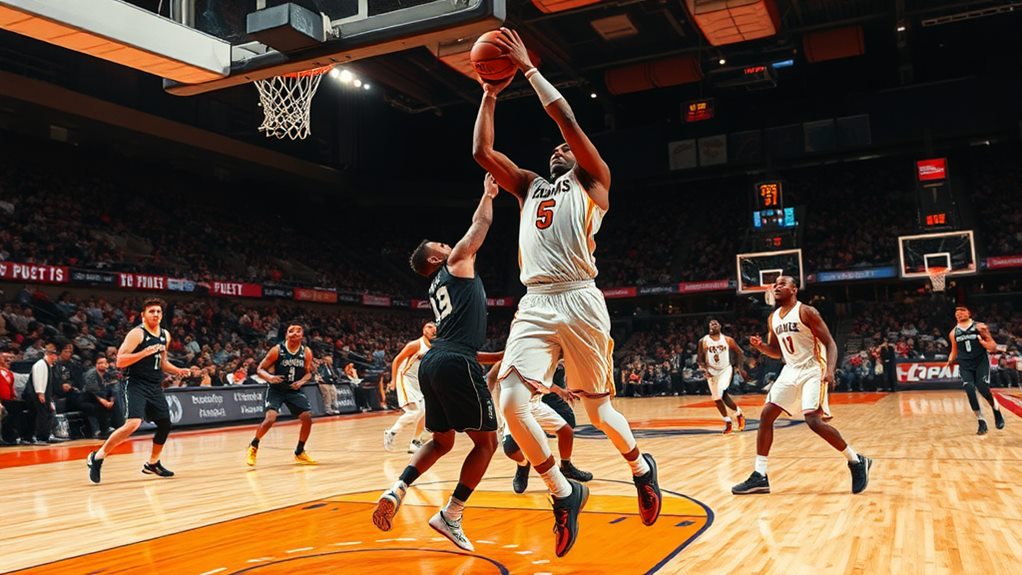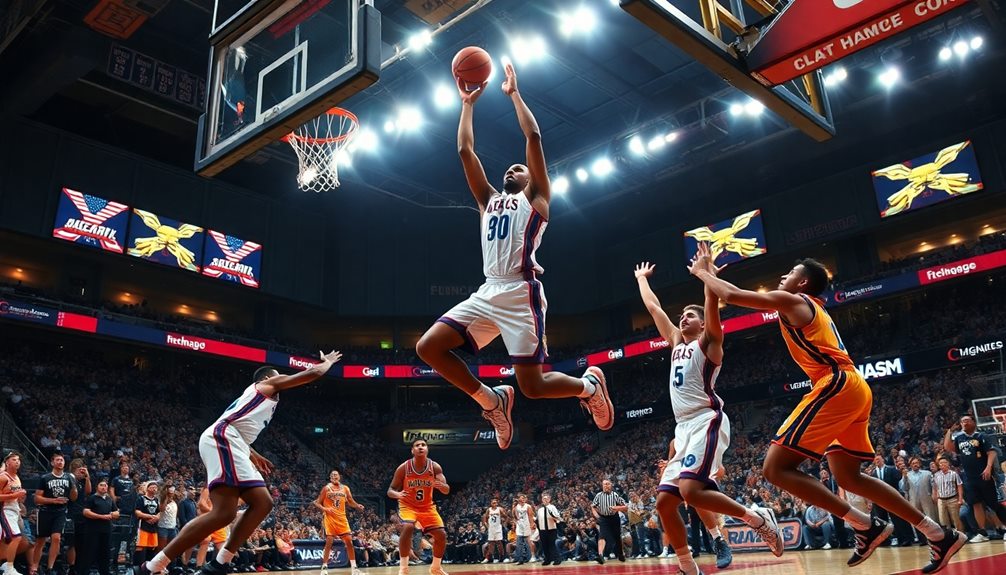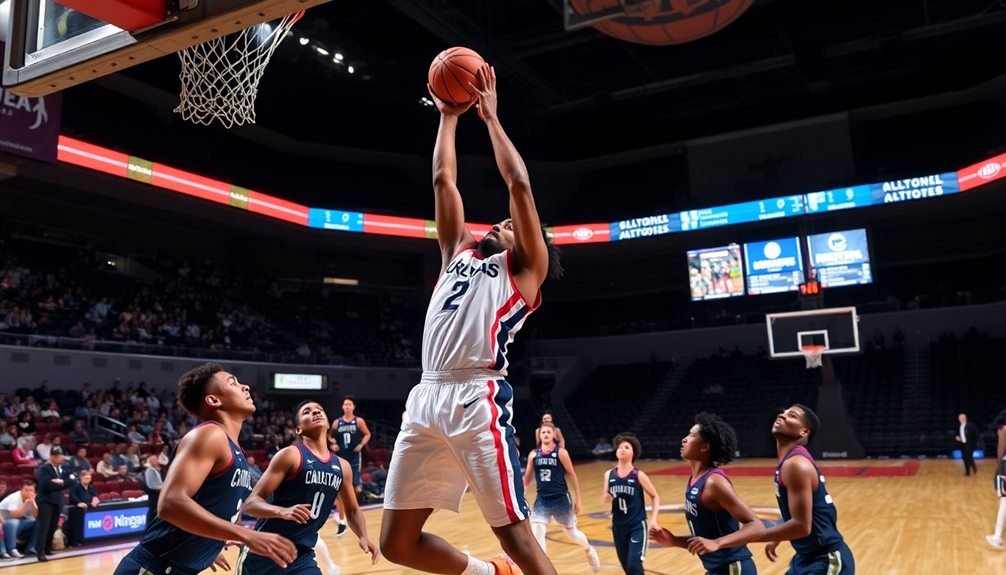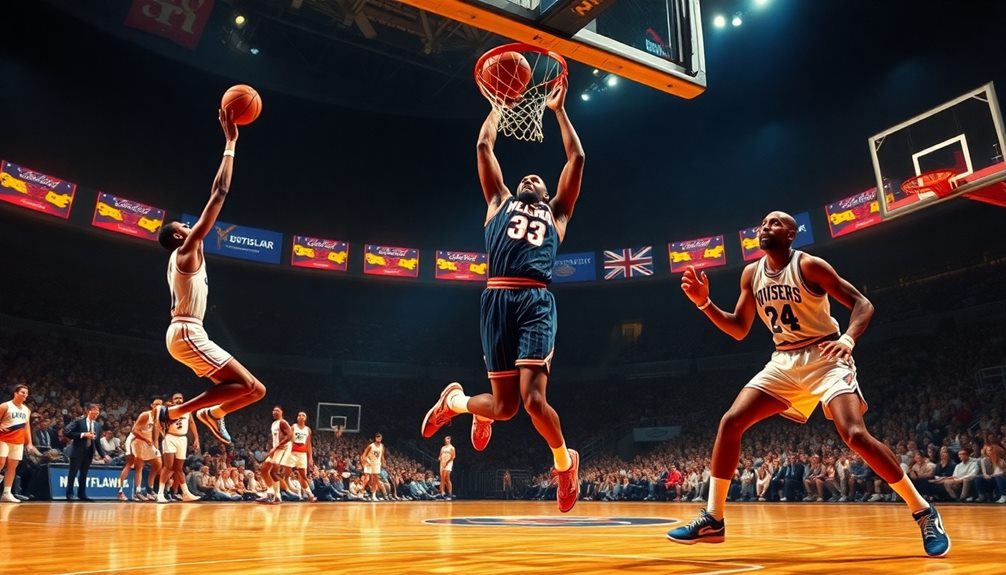
What Does a Center Do in Basketball? The Role Explained
November 29, 2024In basketball, your center plays a significant role, dominating the paint and offering height to secure rebounds. This position focuses on scoring near the basket, using low post moves and hook shots while also setting screens to facilitate plays. Defensively, the center protects the rim by blocking shots and contesting opponents. Your center's rebounding skills are vital, turning defensive efforts into fast breaks. With the game evolving, modern centers also stretch the floor with perimeter shooting. If you want to uncover more about the center's responsibilities and how they impact the game, there's plenty more to explore.
Overview of the Center Position
The center position is often regarded as one of the most essential roles on a basketball team. Typically the tallest player, often around 7 feet tall in the NBA, the center occupies the number 5 spot in basketball positions.
You'll find centers primarily operating near the basket, focusing on scoring opportunities through close-range shots. Their height and strength make them exceptional rebounders, important for securing possession and initiating shift offense.
In modern basketball, centers have evolved to embrace versatility, where their ability to stretch the floor enhances team dynamics and scoring potential. This evolution allows them to create mismatches that can force defensive adjustments, making them even more integral to their team's success.
In addition to rebounding, centers play a significant role in rim protection, acting as shot blockers to deter opponents from driving to the basket. They excel at low post moves, using their size to create scoring chances in the paint.
Modern centers have evolved, too; many now possess perimeter shooting abilities, embracing the "stretch five" concept. This versatility allows them to stretch the defense and create more options for their teammates.
Effective centers also set screens, creating space for guards and forwards to drive or shoot. By combining these skills, you can see how the center position is fundamental to both offensive and defensive strategies, providing a backbone for your team's success on the court.
Key Responsibilities of a Center
Centers take on a variety of key responsibilities that greatly impact a team's performance. As the tallest player on the court, you're positioned close to the basket, maximizing your ability to score and rebound. This positioning allows you to exploit scoring opportunities within regulations, creating a strong offensive presence while also adapting to opponents' defenses as needed.
You'll often be the primary target for passes, utilizing low post moves like a hook shot or layup to convert close-range opportunities.
On the defensive end, your role is essential in protecting the paint. You need to block shots and deter opposing players from driving to the basket. By contesting shots taken by players in the post, you help keep your team's defense solid.
Additionally, understanding the significance of smart defensive tactics can enhance your ability to neutralize scoring threats.
Rebounding is another critical aspect of your responsibilities. You're expected to secure rebounds on both ends of the court, turning defensive stops into offensive chances and leading to second-chance points.
Additionally, you often set screens for guards and forwards. This helps create open shots and facilitates offensive plays, particularly during pick-and-roll situations.
Your unique combination of size and skill makes you integral to both your team's scoring and defensive efforts. Embrace these responsibilities to elevate your team's performance on the court.
Scoring Techniques for Centers

As a center, mastering low post moves is essential for scoring effectively near the basket.
Incorporating speed and agility workouts into your training can enhance your ability to position yourself effectively for scoring opportunities.
You should also look to capitalize on shift opportunities and, if you can, expand your range with three-point shooting to keep defenses guessing.
Each of these techniques can elevate your game and make you a more versatile offensive threat.
Low Post Moves
Low post moves are essential for any center looking to dominate near the basket. As a center, mastering these techniques elevates your scoring potential and helps you capitalize on defensive mismatches. Techniques like drop steps create space for shots, while hook shots leverage your height and positioning to score over defenders.
One effective move is the up-and-under, where you fake a shot to draw a defender into the air, then quickly finish with a layup. This emphasizes your footwork and timing, critical for effective scoring.
Fadeaway shots are also important; they help you create separation from defenders, making it challenging for them to block your shot as you fall away from the basket.
Don't forget about tip-ins! These involve jumping to redirect a missed shot into the basket, allowing you to capitalize on offensive rebounds.
Focusing on these low post moves not only enhances your scoring opportunities but also leads to high-percentage scoring chances that can greatly impact the game. By refining these techniques, you solidify your role in the center position and contribute effectively to your team's offensive game plan.
Transition Scoring
Shift scoring is an essential aspect of a center's game, allowing you to turn defensive plays into quick offensive opportunities. In rapid scoring, you need to run the floor quickly after grabbing a defensive rebound or capitalizing on a turnover. This creates fast-break chances where you can score points with easy layups or powerful dunks.
As a center, you excel at finishing at the rim during these rapid plays. Your height and strength enable you to convert high-percentage shots before the defense can establish itself. Sometimes, you'll even set a drag screen for a guard, facilitating a quick offensive setup that creates mismatches against slower defenders.
Additionally, don't forget about positioning yourself near the basket for offensive rebounds. This strategy can lead to valuable putback opportunities when the initial shot doesn't fall.
Effective rapid scoring requires good conditioning and agility, allowing you to keep pace with quicker players and remain a constant scoring threat during fast breaks. By mastering these techniques, you'll not only enhance your offensive game but also become a pivotal part of your team's rapid strategy.
Three-Point Shooting
Expanding your scoring arsenal to include three-point shooting can considerably elevate your impact on the game. Modern centers like Nikola Jokic and Joel Embiid have proven that scoring from beyond the arc adds versatility to your offensive game.
The "stretch five" concept allows you to pull opposing big men away from the basket, which creates more space for driving lanes and enhances team dynamics.
When you develop your three-point shooting, you become a significant threat on the perimeter. Centers with a shooting percentage of around 35% or higher can stretch defenses, making it harder for defenders to guard you effectively.
This improved spacing not only benefits your scoring opportunities but also helps your teammates find open looks.
Moreover, successful three-point shooting can enhance your rebounding capabilities. With defenders pulled outside the paint, it becomes easier for you to secure boards and control the glass.
Defensive Duties and Strategies
As a center, your primary focus on defense revolves around rim protection and rebounding strategies.
You'll need to position yourself effectively to block shots and secure missed attempts, using your size and strength to your advantage.
Additionally, understanding advanced tactics and formations can enhance your defensive impact.
Mastering these skills not only boosts your team's defense but also sets the tone for limiting opponents' scoring opportunities.
Rim Protection Techniques
While you might think scoring is the primary focus in basketball, rim protection is equally essential, especially for centers. As a center, you become an important rim protector, using your height and wingspan to contest shots near the basket.
Employing techniques like vertical jumps and precise body positioning, you can block shots without committing fouls, which is crucial for maintaining defensive integrity.
To excel, you'll need to anticipate your opponent's moves. This anticipation allows you to position yourself strategically for successful shot-blocks and to alter shots effectively.
Utilizing solid defensive footwork and lateral quickness keeps you in front of driving players, ensuring you're always ready to defend the rim.
Additionally, communication is key. Coordinate with your teammates to execute effective defensive rotations, providing support to guards and forwards when they face drives to the basket.
By mastering these rim protection techniques, you not only enhance your individual defensive skills but also contribute greatly to your team's overall defensive success.
Rebounding Strategies
After mastering rim protection, your focus should shift to rebounding strategies, which play an important role in your defensive duties. As a center, you're significant for defensive rebounding, so positioning yourself near the basket is key to securing boards and preventing second-chance points for opponents.
Utilize your height advantage—ranging from 6'9" to 7'2"—to reach higher for rebounds and effectively contest shots in the paint. Effective boxing out techniques are essential. Use your body positioning to limit the movement of offensive players, ensuring you maintain favorable positioning for rebounds.
When the shot goes up, get low, spread your arms, and make contact with the opposing player to keep them away from the basket. Communication with your teammates is equally important. Call out screens and alert them about help defense to create a cohesive effort in securing rebounds.
Keeping everyone on the same page maximizes your chances of controlling the boards. To measure your efficiency, pay attention to metrics like Defensive Rebound Percentage (DRB%), which indicates the proportion of available rebounds you secure while on the court.
Emphasizing these strategies will enhance your overall impact as a center.
Importance of Rebounding

Rebounding is a fundamental aspect of basketball that can make or break a game. As a center, you play an essential role in securing both offensive and defensive rebounds. Your height and positioning allow you to dominate the glass, limiting your opponents' scoring opportunities and creating second-chance points for your team.
Additionally, effective conditioning is critical for maintaining the stamina needed to battle for rebounds throughout the game. In fact, elite centers often lead their teams in rebounding, averaging over 12 rebounds per game in the NBA.
Defensive rebounds are especially important, as they enable quick shifts to offense. After grabbing a rebound, you can outlet the ball to your guards, initiating fast breaks that catch the defense off guard. This ability to control the boards not only prevents opponents from getting extra possessions but greatly influences the outcome of the game.
Moreover, you'll often rely on boxing out opponents during shot attempts. By establishing the best position, you increase your chances of grabbing the rebound and maintaining control of the game.
Effective rebounding elevates your overall value as a center, making it a skill you must continuously develop to help your team succeed.
Evolution of the Center Role
As basketball has evolved, so has the role of the center. Gone are the days of traditional big men who focused solely on rebounding and shot-blocking. Today's centers are versatile players who excel in perimeter scoring and playmaking, reflecting the trend of optimizing player roles based on individual strengths and weaknesses data-driven strategies.
The introduction of the three-point line in the 1979-80 season sparked this evolution, leading to the rise of the "stretch five." These players not only shoot from long range but also contribute considerably to their team's offensive flow.
The small ball revolution of the 2010s further transformed the center position, reducing the emphasis on low-post roles. Teams like the Miami Heat and Golden State Warriors now utilize positionless lineups, showcasing centers who can do it all.
Modern centers, such as Nikola Jokic and Joel Embiid, exemplify this shift by combining elite playmaking skills with the ability to score from various spots on the court.
Moreover, centers now engage in screen setting and even initiate fast break offense, reflecting a broader change in basketball strategies influenced by international styles.
This evolution highlights how the center's role has expanded, making it one of the most dynamic positions on the court today.
Notable Centers in History

The legacy of notable centers in basketball showcases the evolution of the game and the impact these players have had on their teams and the sport itself.
Bill Russell, a 6-time NBA champion, is celebrated for his defensive prowess, dominating as a shot blocker and rebounder. His 11 championships with the Boston Celtics underscore his importance to championship teams, much like England's first FIFA World Cup victory highlights substantial achievements in sports history.
Kareem Abdul-Jabbar, standing tall at 7'2", is the all-time leading scorer in NBA history, boasting 38,387 points, largely thanks to his signature skyhook shot. He not only excelled on the offensive end but also contributed considerably on defense.
Hakeem Olajuwon, known for his exceptional footwork, led his teams to two NBA championships and earned the MVP award in 1994, showcasing how centers can impact both ends of the court.
Wilt Chamberlain, infamous for scoring 100 points in a single game, holds records that highlight his high-scoring abilities, including a career average of 30.1 points per game.
Then there's Shaquille O'Neal, a dominant force who won four championships and was named NBA Finals MVP three times, further solidifying the center's vital role in the game.
Conclusion
So, you thought the center just hangs around the basket, right? Ironically, they're often the unsung heroes of the game, balancing finesse with brute strength. With their scoring, rebounding, and defensive prowess, centers play an essential role in shaping team dynamics. As the game evolves, the center's responsibilities continue to transform, proving that this position is anything but stagnant. Next time you watch a game, keep an eye on the center—there's a lot more happening than you might think!


